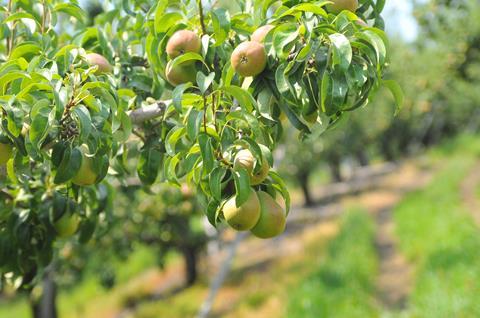
Northwest pear growers have released fresh pear harvest projections for 2016 following their annual meetings in Portland last week, according to Pear Bureau Northwest.
Collectively, Washington’s Wenatchee and Yakima regions and Oregon’s Mid-Columbia and Medford regions estimate a fresh pear harvest of 18.7m cartons, or 414,000 tonnes. These figures are up 2 per cent from 2015 final harvest figures, but represent a 7 per cent decrease from the five-year average.
Warm spring weather and good pollination led to a full bloom, with no significant weather events to impact the fruit finish, according to a media release from Pear Bureau Northwest. “Growers are reporting beautiful, clean fruit that is filling out nicely in terms of fruit size,” stated Kevin Moffitt, president and CEO of Pear Bureau Northwest (PBNW).
Harvesting is expected to begin slightly earlier than the historical average, but similar to the last two years, with Starkrimson set to come online in the last days of July, Bartlett in the first days of August, and Anjou, Bosc, and Comice in the last two weeks of August, across the four growing regions. Concorde, Forelle, and Seckel will be picked from late August through September.
The top three varieties produced by Northwest growers remain the same as in previous years: Green Anjou pears are expected to make up 50 per cent of the total 2016 crop, and Bartlett and Bosc pears are expected to yield 23 per cent and 17 per cent respectively.
Volumes by variety
Green Anjou pears are showing a projected crop decrease of 3 per cent compared with 2015, and a 13 per cent drop compared to the five-year average.
Growers estimate that the Bartlett pear crop yield will increase by 9 per cent compared with last season’s results, matching the five-year average.
The Bosc pear crop is expected to be up by 4 per cent over the 2015 harvest, 3 per cent higher than the five-year average.
The Red Anjou pear crop is set to be 3 per cent higher than last year, but down by 3 per cent compared to the five-year average.
Certified organic pears are projected to make up about 6 per cent of the total crop, with more than 1.1m cartons (or 24,279 tonnes) projected for 2016, up14 per cent compared with 2015.
Building demand
“The industry expects a crop of excellent quality fruit with ample supplies for both the domestic and export markets,” said Moffitt. “The Pear Bureau will help keep demand for pears high worldwide through marketing communications, educational and promotional programmes, and consumer sampling at retail and at events, maximising profits for growers.”
While much of the crop is marketed domestically in the US, export markets (including Canada) remain a vital part of the success of the industry and typically account for around 40 per cent of the total sales in a given season, according to Global Trade Atlas.
PBNW conducts promotional activities across nearly 30 countries worldwide. The programme targets both consumers and trade with the aim of increasing awareness on ripening, varieties, nutrition, and usage to build demand. Activities in top markets – including Mexico and Central America, India, Middle East and South East Asia – will include in-store sampling, Northwest pear nutrition workshops, consumer advertising, movie promotional tie-ins, social media and event activations. In the industry’s largest export market, Mexico, PBNW is using its retail pear category data to identify the opportunities for new varieties, size and grades of Northwest pears with major retailers.
Pearing up
One key industry initiative for this season is “PearUP!”, a drive to tie-up with industry partners, including commodity boards, industry experts, cross-store vendors and food industry segments, to expand the reach of Northwest pears across retail, digital communications and events.
“Partnerships with wine and cheese brands and other ‘pear-able’ ingredients like packaged salads, nuts, and yogurt create buzz and excitement about Washington and Oregon pears,” said Moffit. “Teaming up with industry colleagues like The Produce Mom and Produce for Better Health expands our reach and support.”






No comments yet